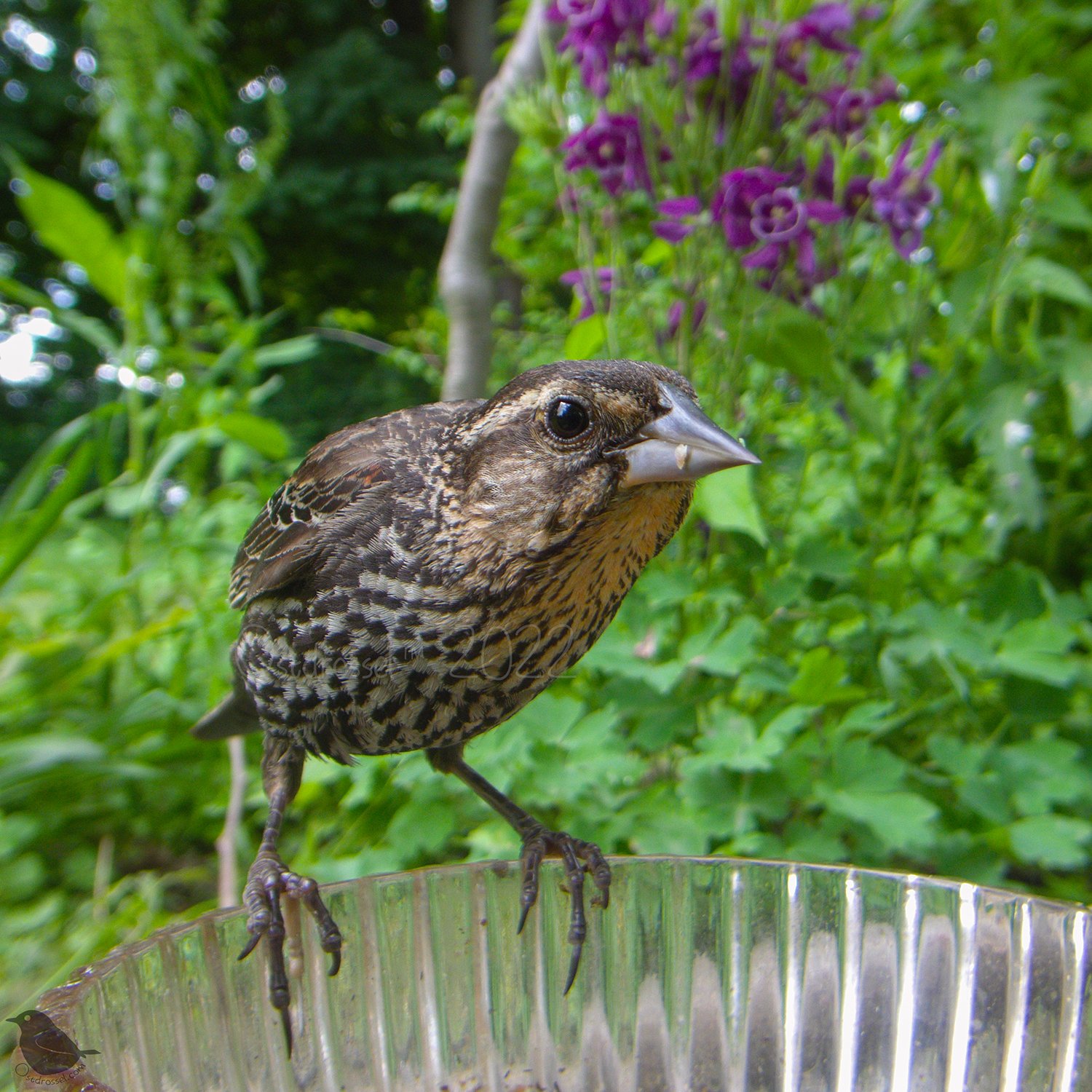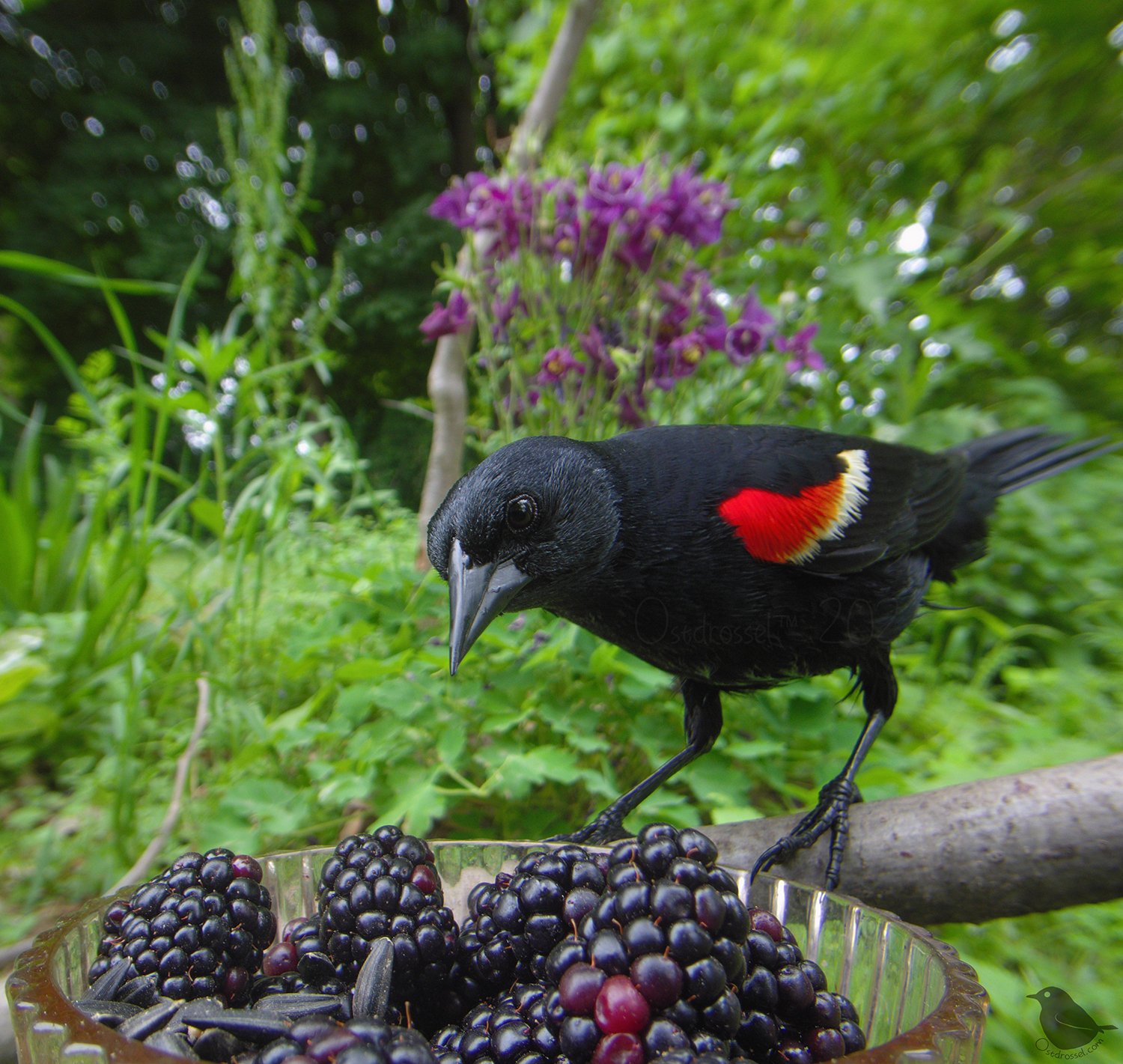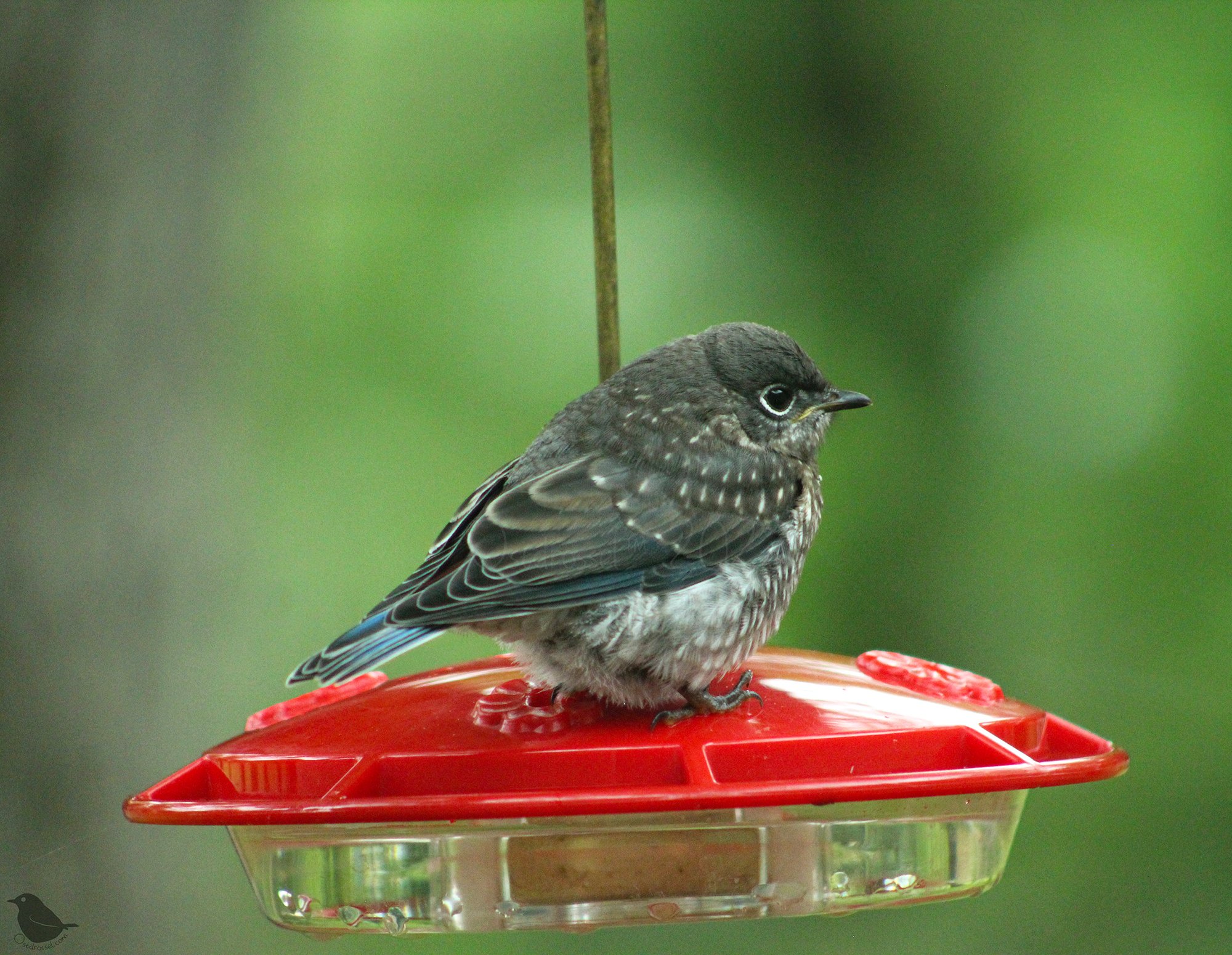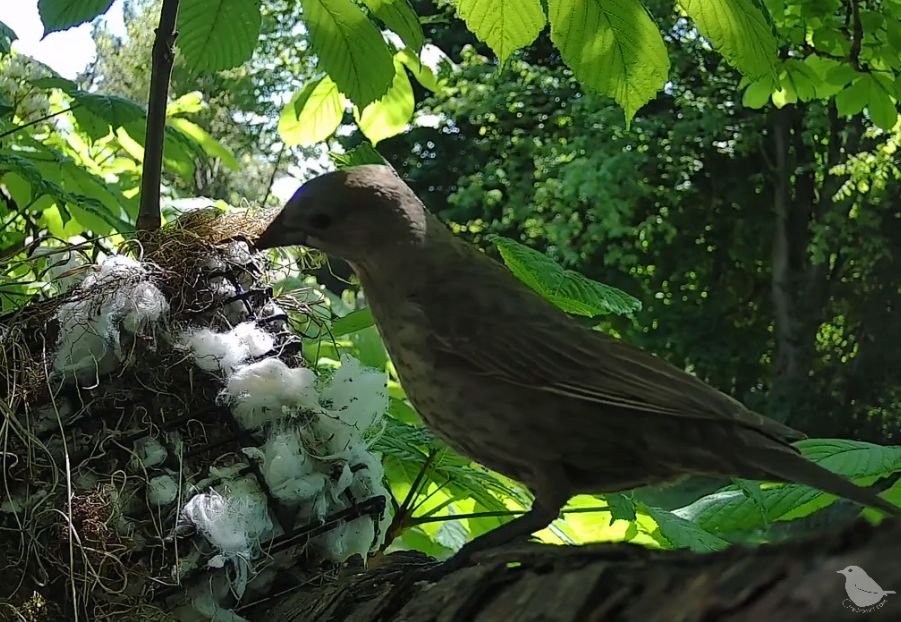I haven't posted Blue Jays in a bit,
but they are around, raising babies and also still flirting. There is at times a lot of wailing and begging going on. This one showed off in the bright sunshine. I cannot wait to see the youngsters.
Redwinged Blackbirds are interesting
Redwinged Blackbirds are interesting to me because they are one of the harbingers of spring, they carry the German flag and a Pearl Jam song on their feathers, they have an interesting song and they are feisty when they defend a nest. They are also very beautiful, and the females none less than the males. In recent days, I have seen females a lot all over the yard and feeders, so there were good opportunities to get photos. I love the faint red on their shoulders.
European Starlings are considered invasive
in the US, meaning that they are not a native bird over here. They were supposedly brought to America through a man named Eugene Schieffelin who released a bunch of them in Central Park in 1890 as part of a personal project to bring all birds that have been mentioned in Shakespeare to the New World. Starlings have experienced a success story in the US, much to the detriment of some native species that were not prepared for them. As an invasive species, they are not protected by the Migratory Bird Treaty, so people are allowed to take active measures to control them. Many American bird enthusiasts are not a huge fan of them. However, they are part of the bird world here, they are fascinating in their own right, and I find it important to show them every so often too so people can recognize them and maybe become a bit more aware of their impact. (Plus, they can be entertaining and I also have followers from their native region.) There are lots of ressources about Starlings and the other main invasive bird in the US, the House Sparrow, to be found online. Here is one link with some background in regards to Schieffelin link. For an alternative view, here is another link, it is a complex topic. Without further ado, here is a young European Starling.
I loved the Grack photos so much
that I put a camera on the ground again. And this time, he was less shy. Baby birds always look so cute with their off proportions, different feathers and the vibrantly colored gape, the soft flesh around the beak base. In Grackles, it is pink, Bluebirds have an egg yolky yellow, for example. The vibrant gape is a good marker to identify a baby bird, and it also gives them their pouty appearance. There are actually several young Grackles around, in the second photo you can see that the youngster already starts to get some purple specks on the head too, so he is a bit older.
(Bonus photo of a Red-winged Blackbird is second-to-last.)
We did more gardening this weekend,
also because there isn’t a lot of bird activity going on because everybody is either incubating or taking care of very young babies. For a change, I did put a camera on the ground because I wanted to see if I could get photos of one of the adorable Grackle babies that have started to show up. And I was lucky. As you can see, they are very demanding, but Grackles are excellent parents and will dutifully feed those pink lined beaks. As always when there’s a camera on the ground, some squirrels also came by. This one had such a hilariously smug look on his face that I included him here even if he is out of focus.
In nestbox news, Gayle is incubating her five eggs and learned how to handle the Wren guard, and the Wren has surprisingly laid an egg the other day in the other box. I had kept removing sticks to keep the Wrens busy but they apparently were more determined than I anticipated. She has three eggs as of today. Interfering with an active nest of a native bird is illegal, so they can do their thing now. Hopefully, the Wren guard on the BB box will continue to work and all will be well. The Wren chose the two-holed PVC box with 6 inches in diameter. Since other birds keep exploring that box as well, I have added a hole reducer so that only Wren size can enter. Here’s to a good week!
The BB babies
are now confident enough to fly around the yard by themselves and also visit the feeders. There is at least one male (you can tell by him already having more blue feathers than the girls). Gayle has laid her fourth egg today, and so far, the Wren guard seems to work too. The next couple of weeks will be fun with loads of babies coming to the backyard.
Earlier today,
I heard and saw the first Grackle baby. They have a very cute distinctive call (a bit like “naag-naag”) that is completely different from the cursed sounds of baby Starlings. This must have been an early one though, the Grackles are still carrying food away by the beaksful. They supplement with stuff from the feeder but feed the babies mainly with all kinds of juicy insects from the garden, of which you can see a bit of a selection here. The other two photos were just a weird pose that I found too funny not to share.
Nestbox news: Oh yes!
Yesterday was the day, Gayle started her second brood, and added another egg this morning. As soon as the egg was laid, I put a Wren guard on the box to keep the tiny destroyers out of there. It is like a visor for the nextbox that hides the entrance hole from sight, so that the Wren does not see it and thus, will not explore it and destroy eggs or babies. Since the BB has an egg in the box, she is bonded with it and will overcome any possible fear of the guard. Only the BBs know that there is a nest there, so it gives a bit of safety. We will see how that goes. The BBs have one advantage - they have at least four of their first babies around that can possibly help to defend. The guard will stay on the box until the babies are about 5 days old. Then they are too big and heavy to be drug out by the Wren. And here is a pic of two of the first babies with Dad at the feeder!
The weekend
was a lot of fun and felt like summer. The birds are all somewhat busy with nestbuilding and offspring, and things are a bit quieter right now. Except for the Starling babies, that is. Here are some of the current regulars, some are immature, some apparently feeding babies. (Grosbeak, Robin, Blue Jay, Grackle, Baltimore Oriole, MoDo, Hummer, another Blue Jay, a Redbellied Woodpecker and a sassy Finch couple)
Nestbox news: Ready for round two.
The babies have fledged on May 14, and in the last few days, the parents have started to bring them back to the yard to introduce them to the feeder and amenities. At the same time, Gayle has started to build another nest. During the time after fledging, a Bluebird box is pretty much left unattended and thus, vulnerable to other birds claiming it. A House Wren that is nesting in the area has discovered it and explored. And two nights ago, went in and started tossing the newly started BB nest. All night I was trying to think about what I could do. Then in the morning, I watched this scene going down. First thing in the morning, the Wren came back, but this time, Mr. Business saw it and took care of business. Gayle continued to build afterwards, and the Wren has not returned. As soon as she lays her first egg, I will install a Wren guard, which is basically a visor for the box that disguises the entrance hole from view. Theoretically, only the BBs know it is there. Since the Wren was already in, I have no idea if this will work, so I have to hope for the best. But the whole family is around, including three babies (that I saw so far) who stay close by the box and will hopefully defend it.
Video: I put a little station
with nesting material on the chestnut tree to see if anybody would take some. Activity has been low on this camera, but the other day I saw something interesting. A female Cowbird came to inspect the material. She must have thought it was a nest. Brownheaded Cowbirds are so-called brood parasites. They lay their eggs in other birds’ nests and let them raise their young. Later in the season, the whole family will flock and migrate together. This was recorded with one of my Birdsy cameras. They are having a Memorial Day Sale right now too, go and check it out at birdsy.com.
A happy sight
this morning - Gayle and Mr. Business are bringing the babies closer and I was lucky to get a little glimpse of one of them getting fed by Dad. I am not sure how many are there, sometimes not all of them make it in the wild. Gayle has ramped up her building efforts this morning too and is quickly filling the box. I am glad they hang around more now and I hope the Wren stays away. Have a great Wednesday!
Gayle and Mr. Business
have been teaching their babies how to live and survive in the world, and they have started to bring them to the backyard. I have heard them begging and saw some glimpses but they are still keeping them up in the trees. Gayle has also started to build another nest yesterday. I hope to see the babies up close soon too.
I think it is safe to say
that the Grackles have babies now. I love this time of the year, because I get to see what crawls and lives in my backyard by the stuff the birds bring on their shopping trips for the young ones. I also saw a young Starling today.
The beginning of May,
my favorite month of the year, is also the point in time when the serviceberry blooms. And everybody comes to pose in front of it. (male Rosebreasted Grosbeak, Blue Jay, Grackle (‘tis the Count himself!), MoDo, female Redwinged Blackbird, female Rosebreasted Grosbeak)
Vitamin O to start the week!
We had the the first real thunderstorm and rain pour of the season. The yard’s vegetation has pretty much exploded and the bird songs have calmed down because many are busy building nests. Last week, I saw the first female Oriole (see first photo), and there is a good group of them visiting. It is funny to me how much they can differ in color. On of these is of course the Orchard Oriole, so it is generally darker.
Nestbox news: They're getting so big!
I have been slacking a bit with the videos, so today there's more than one. This is from two days ago, and I thought it was funny to see Gayle sitting with the babies for a bit. They are in the tufty stage here, with feathers growing all over the place. At times it looked like mommy was plucking some of the tufts away but I am not sure if that is actually the case. Of course, once Mr. Business arrives, it's all mayhem again.
This is also from May 9. Here you can see the babies preening and stretching. They look so cool with the different colors and textures happening. The new feathers are encased in sheaths, almost like in a straw, and when the babies nibble that off, "feather dust" is in the air.
Now this is from last night. In the last two days, the babies have started wing practise. In order to be able to make the first flight, they need to be strong enough to not just drop. And this is where this larger nestbox hopefully proves its worth. With more space in the box, the babies have more space to practise. It won't be much longer now until fledging. These guys look awesome.
Usually when the Orioles arrive,
I also get lucky to see an Orchard Oriole too. This year does not disappoint in that respect. He has been here for a couple of days now, he likes to chatter, and I hope he sticks around a bit and maybe brings the wife. Apart from the difference in color, Orchard Orioles are also smaller than Baltimore Orioles. Immature males are yellow with a distinctive black bib. I had one one year and always hope to see it again.
Happy Mother's Day!
It is a beautiful spring day here, and I hope you all get spoiled today. Thank you for all you do, you make this world a better place.
Nestbox news: 3 minute mayhem
Sorry, yet another Bluebird baby post. But they are very entertaining and exciting to watch right now. The babies are now 12 days old, their eyes are open, they are still napping a lot but are also more aware and awake. The feathers are really coming in now, giving them an odd apearance with fluff as well as hard sheaths. They are grooming a lot to open the sheaths. And every three minutes, an adult bird comes to feed them. I love these little grumpy faces so much.



































































